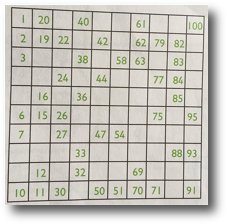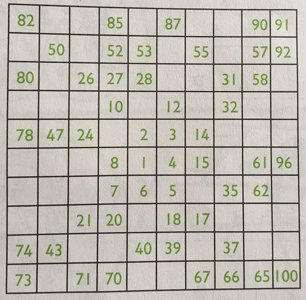Place a digit
Pupils draw four rectangles divided in half to record digits as 2-digit numbers. Explain that they will be shown two digit cards from a set of 0-9 cards and they must decide where to write the digits to make the largest number. Give further instructions:Now make the smallest number you can from those digits.
Is your number odd or even?
Can you use your digits to make an odd number?
Here are the digits 8, 5, 4, 0. Make a number btween 40 and 50. Make another one.
This can be extended for numerals beyond 100, using 3 boxes for each number.
Make a number
Organisation: groupsPupils choose six pieces of base 10 apparatus and make a two-digit number. They choose another six pieces and make a different number. Repeat this four times. They record their numbers in order, such as 32, 15, 33, 42, 51, …
Mental numbers
Pupils sit with their eyes closed and imagine a number written on the inside of their eyelids. thoughout the activities they keep their eyes closed and imagine the number changing with activities such as:Imagine the number 46.
Which digit is in the tens column? Which digit is in the ones column?
Change over the position of the 4 and 6. What does the new number say?
Make the number 1 more. What does it say now? Now make this number 10 more. What is the new number?
Decide whether to extend the activity to include imagining mental numbers in the hundreds.
Make a hundred
Organisation: groupsPupils roll two dice, add the scores and make the score in base 10 apparatus. They change ones for tens until they reach a hundred. The first to reach a hundred wins.
Break a hundred can be played with the same apparatus as Make a hundred. Here pupils remove their score from a hundred, exchanging tens for ones. The first to reach zero wins.
Make five hundred and Break five hundred can be played in the same way.
My number is …
Organisation: groupsA pupil thinks of a number. The others take turns to ask a question about it which can only be answered yes or no.
Is your number less than 50? Yes.
Is your number between 20 and 30? No.
Is your number odd? Yes.
Is the tens digit bigger than the ones digit? Yes.
This continues until someone guesses the number then that pupil ‘thinks of a number’.
Place value game
Organisation: pairsPairs use base 10 apparatus, shuffled Digit cards 0-9 placed face down and strips of 10 squares. They each take two cards, make the largest number and show it with the apparatus. The pupil with the larger number colours a square on their strip. The first to colour ten squares wins. The activity can be repeated for making the smallest number. Extend to three cards and numbers above 100 if appropriate.
Elastic-band strips
Use unmarked strips of card - they can be of almost any size, say about 30cm long by 5cm wide, and need not all be the same size. Each pupil has a card strip with an elastic band looped over 2 or 3 times so that it can slide along the strip.Tell pupils that one end of the strip is zero and the other end is 10.
· Ask them to slide the band along the strip to where they think 5 is positioned. They then hold the strips up to show their estimations.
· Repeat for different numbers between 0 and 10. Discuss how the positions are approximate.
Repeat, with one end of the strip zero and the other end 100.
· Ask pupils to slide the band along the strip to where they think 55 is positioned.
· Repeat for different numbers between 0 and 100. Discuss how the positions are approximate.
· Extend the activity to using the number range 0-1000. Discuss rounding numbers to the nearest hundred.
Number clues
Explore different two-digit numbers with the pupils. Say:I have written a list of different whole numbers.
- There are no zeros in any of my numbers.
- The digits of each number adds up to 7.
Ask them to write a list of the possible numbers.
- What is the smallest number?
- What is the largest number?
Reverse the digits
Organisation: pairsPupils take turns to enter a two-digit number on their calculator. The other decides what to enter in order to reverse the digits, such as changing 35 to 53.
Mental number tracks
Pupils sit with eyes closed and imagine parts of number tracks written on the inside of their eyelids. Throughout the activities they should keep their eyes closed and imagine that they are jumping forwards and back along the track. A jump is from one number to another, unlike a step which is from one number to the next.Set mental problems such as:
Stand on number 64 and jump three forwards. Where are you?
Now jump three backwards. Where are you?
Stand on 83 and jump six backwards. Where are you?
Now jump six forwards. Where are you?
Jump from 34 to 40. How large a jump?
Jump from 40 to 34. How large a jump?
Change the starting number and set similar problems.









